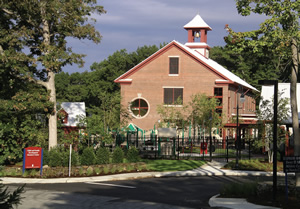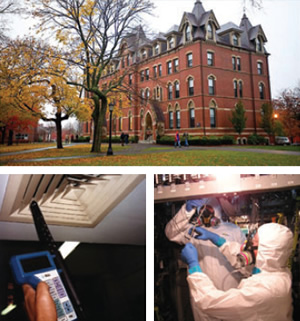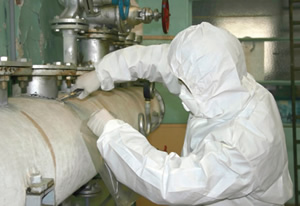A Plan for Healthy Buildings
Common environmental hazards can lurk in facilities. Identifying and removing them are vital to maintain a healthy campus.

PHOTOS COURTESY OF FUSS & O’NEILL
Colleges and universities across the United States face hidden environmental hazards and building contaminants that can have far-reaching implications for the health and well being of faculty, staff and students. Some, such as asbestos and mold, are well known. Other hazards are more of a mystery to administrators, but deserve no less attention.
Environmental hazards can be found in buildings of all types and ages; administrators need to be aware of the risks that may be present in their buildings and on their campuses. Strategic plans should be in place for dealing with those hazards.
The Hazards You Know
Two common hazards with which many administrators are already familiar are asbestos and mold. These contaminants have received a lot of media attention throughout the years, and many institutions have already had to address them.
Asbestos was widely used as a flame retardant and insulator in buildings, starting in the early 1920s and continuing until the late 1980s. Long-term exposure can lead to a host of lung issues and diseases.
Many schools and universities have been faced with these building contaminants, and those that have not been tested or undergone abatement in the past should be proactive about testing for asbestos. If testing finds damaged or friable (crumbling into small particles that can become airborne) asbestos, that contamination needs to be addressed. Asbestos removal is required prior to renovation or demolition, which would disturb the materials and potentially cause their disbursal into the air. On the other hand, if no additional construction is planned and the asbestos is not damaged, it may be better to leave the asbestos in place without disturbing it. However, if materials are damaged or friable, then abatement should always be performed, which could include repair, encapsulation or removal.
Abatement should always be managed by accredited and licensed contractors with both the experience and resources to safely abate the asbestos. It should never be treated as a do-it-yourself project to be handled by maintenance staff members who aren’t specifically trained and licensed to work with asbestos.
Another common contaminant that’s often present at colleges and universities, particularly in older buildings, is mold. It’s easy to be complacent about mold since it’s so common, but it can pose significant health risks. For instance, mold can trigger asthma symptoms in those who are susceptible, and in extreme cases it can even lead to pneumonia. Severe reactions may include fever and shortness of breath, and some people with chronic lung illnesses, such as obstructive lung disease, may develop mold infections in their lungs.

GET TESTED. Be proactive about testing for asbestos in older facilities that have not previously been tested or undergone abatement. Contaminants can be particularly problematic when located in HVAC systems because they can be transmitted through air conditioning and heating.
Mold is very common and can typically be found in damp and humid locations within campus buildings. These can include basements, wall spaces where water is present, and other moist and humid spots. Mold can be particularly problematic when it develops in HVAC systems because the mold spores are so easily transmitted through air conditioning and heating.
Identifying mold is relatively simple, as long as you know where to look and what to look for. Professionals who are familiar with the standards established by the Environmental Protection Agency, however, should oversee remediation. Mold is practically omnipresent, and it can be easy to overlook the fact that it’s a contaminant that can cause serious health problems. Campus administrators should take the risk seriously.
A final common and well-known contaminant that is present in most older colleges and universities is lead paint. Lead is mostly a concern to younger children whose neurological systems are still developing. There are, however, situations in which lead contamination can cause issues. One of these situations is where day care services or housing are being provided to children. If these day care facilities or housing are in older buildings, administrators must be aware of the risk, particularly where lead paint may be present on surfaces.
Secondly, lead and other heavy metals can pose risks to workers who are doing basic maintenance, such as sanding and painting. In these cases, surfaces should be checked for lead and other metals, and workers advised, as necessary, to wear personal protective equipment — including respiratory protection — to make sure they aren’t inhaling or ingesting contaminants.
A Hidden Hazard
A more recent hazard, and one that’s likely unfamiliar to many college and university administrators, is Polychlorinated biphenyls, or PCBs. Up until the early 1980s, PCBs were used extensively in oils, caulkings and coatings, serving as plasticizers, coolants and insulators. They could be found in a huge array of products, including lighting fixtures; electrical and electronic components; lubricating oils; sealants such as caulking, wood floor finishes, waterproofing compounds; and paint.
PCBs have been linked to cancer, particularly non-Hodgkin lymphoma, and have been banned for more than 30 years. However, they can still be found in many different places, including older college and university buildings. In educational settings, they are most commonly found in light ballasts, transformers, caulking, adhesives and painted surfaces.
Whereas testing and remediation procedures for other contaminants are pretty straightforward, when it comes to PCBs, the story is not as clear. Although the threat posed by PCBs was recognized in the mid-1970s and manufacture was banned in 1979, there are no federal regulations — or even guidelines — for if and when testing should be done, and what should be tested. In fact, the only real guidance offered by the federal government is the requirement that when PCBs are found, they must be remediated.
The challenge facing colleges and universities, then, is whether to test for PCBs and if so, where on campus to conduct testing. This is where the institution’s relationship with an environmental consultant is particularly important. Campus administrators and maintenance officials must be able to trust that their consultant is able to recognize individual risks of PCB exposure. An appropriate testing plan should not put the school at risk for unnecessary cleanups (requiring the closing of academic or other buildings for months at a time while the cleanup proceeds).
 There’s a real balancing act that must be maintained when it comes to testing for PCBs. On the one hand, there’s the risk that too wide a testing program will find large amounts of contamination, which would need to be remediated at potentially huge costs. On the other hand, there’s the risk of doing nothing and exposing staff and students to potential health hazards. Further complicating matters is the fact that some states haven’t been willing to wait for the federal government to act and have put in place their own requirements and guidance for testing and remediation. Ultimately, an institution’s environmental consultants should be sufficiently experienced and qualified to provide meaningful guidance about when testing is called for and how to proceed.
There’s a real balancing act that must be maintained when it comes to testing for PCBs. On the one hand, there’s the risk that too wide a testing program will find large amounts of contamination, which would need to be remediated at potentially huge costs. On the other hand, there’s the risk of doing nothing and exposing staff and students to potential health hazards. Further complicating matters is the fact that some states haven’t been willing to wait for the federal government to act and have put in place their own requirements and guidance for testing and remediation. Ultimately, an institution’s environmental consultants should be sufficiently experienced and qualified to provide meaningful guidance about when testing is called for and how to proceed.
Taking Control Of The Hazards
Hazardous materials such as asbestos, lead and PCBs, as well as natural contaminants like mold, can pose significant hazards to faculty, students and staff alike. Because each contaminant is different, and the situation facing each college or university is unique, it can be challenging for campus administrators to know how to be proactive to minimize — or eliminate — the threats posed. However, it is essential for campus administrators to remain vigilant when it comes to addressing environmental hazards. By working closely with their environmental consultants, college and university administrators can create and implement strategic environmental plans that will make their campuses much safer and healthier places to learn and work.
This article originally appeared in the issue of .